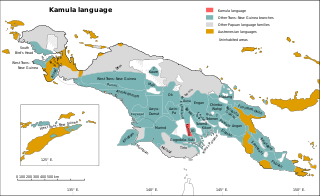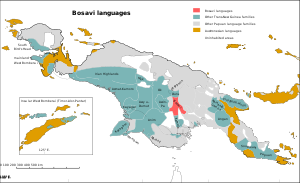
The Papuan languages are the non-Austronesian and non-Australian languages spoken on the western Pacific island of New Guinea, as well as neighbouring islands in Indonesia, Papua New Guinea, Solomon Islands, and East Timor by around 4 million people. It is a strictly geographical grouping, and does not imply a genetic relationship.

The Mantion–Meyah or (South) East Bird's Head languages are a language family of three languages in the "Bird's Head Peninsula" of western New Guinea, spoken by all together 20,000 people.
The Piawi languages are a small family of Papuan languages spoken in the Schraeder Range of the Madang Highlands of Papua New Guinea that had been part of Stephen Wurm's Trans–New Guinea proposal. They are now connected to the Arafundi and Madang languages.

The Central Solomon languages are the four Papuan languages spoken in the state of Solomon Islands.
Elseng is a poorly documented Papuan language spoken by about 300 people in the Indonesian province of Papua. It is also known as Morwap, which means "what is it?" ‘Morwap’ is vigorously rejected as a language name by speakers and government officials.

The Kaure–Kosare or Nawa River languages are a small family spoken along the Nawa River in West Papua, near the northern border with Papua New Guinea. The languages are Kaure and Kosare.

The Duna–Pogaya (Duna–Bogaia) languages are a proposed small family of Trans–New Guinea languages in the classification of Voorhoeve (1975), Ross (2005) and Usher (2018), consisting of two languages, Duna and Bogaya, which in turn form a branch of the larger Trans–New Guinea family. Glottolog, which is based largely on Usher, however finds the connections between the two languages to be tenuous, and the connection to TNG unconvincing.

The Kamula–Elevala languages are a small family of the Trans–New Guinea languages spoken in the region of the Elevala River.

The East Strickland or Strickland River languages are a family of Papuan languages.
The Demta–Sentani languages form a language family of coastal Indonesian Papua near the Papua New Guinea border.
The Etoro, or Edolo, are a tribe and ethnic group of Papua New Guinea. Their territory comprises the southern slopes of Mt. Sisa, along the southern edge of the central mountain range of New Guinea, near the Papuan Plateau. They are well known among anthropologists because of ritual acts practiced between the young boys and men of the tribe. The Etoro believe that young males must ingest the semen of their elders to achieve adult male status and to properly mature and grow strong.
Pyu is a language isolate spoken in Papua New Guinea. As of 2000, the language had about 100 speakers. It is spoken in Biake No. 2 village of Biake ward, Green River Rural LLG in Sandaun Province.

Kaluli is a language spoken in Papua New Guinea. It is a developing language with 3,100 speakers. Some people refer to this language as Bosavi, however the people themselves refer to the language as Kaluli. There are four dialects, Ologo, Kaluli, Walulu, and Kugenesi. The differences between the dialects are not clear. Their writing system uses the Latin script. Kaluli belongs to the Trans-New Guinea language family. Kaluli was first analyzed by Murray Rule in 1964 who wrote a preliminary phonological and morphological analysis. A dictionary of Kaluli has been compiled by Schieffelin and Feld (1998).

Pawaia, also known as Sira, Tudahwe, Yasa, is a Papuan language that forms a tentative independent branch of the Trans–New Guinea family in the classification of Malcolm Ross (2005).

Kamula is a Trans–New Guinea language that is unclassified within that family in the classification of Malcolm Ross (2005). Noting insufficient evidence, Pawley and Hammarström (2018) leave it as unclassified.
Beami is a Papuan language of Papua New Guinea. Komofio is a dialect.
Edolo (Etoro) is a Papuan language of Papua New Guinea, spoken by the Etoro people. As of 2015, there were 300 monolingual speakers. It is part of the Bosavi branch of the Trans–New Guinea language family.
Dibiyasoa.k.a.Bainapi is a Papuan language of Western Province, Papua New Guinea.
Turumsa is a possibly extinct Papuan language of Makapa village in Gogodala Rural LLG, Middle Fly District, Papua New Guinea. It has been classified as a Bosavi language, and is 19% lexically similar with Dibiyaso, but this appears to be due to loans. It has a greater (61%) lexical similarity with Doso, its only clear relative.

The Papuan Gulf languages are a proposed language family of Papuan languages spoken inland from the large gulf that defines the shape of southern Papua New Guinea.











